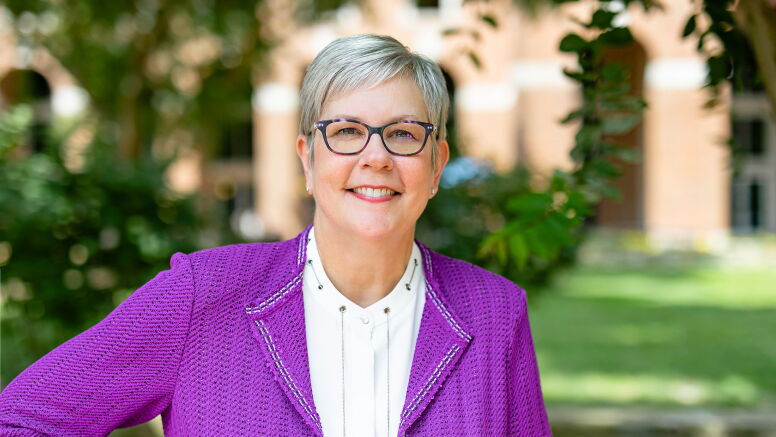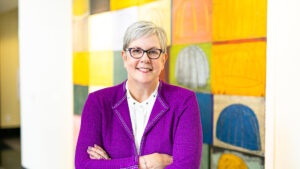News & Stories
The power of communication

Whether it’s a short text message or a long report, business communication is never just about what’s being said, but how it’s said.
Effective business communication is a skill that requires a strategic approach and precision.
Language and communication channels evolve, and as a management and corporate communication professor Patricia Harms keeps up with it all. During her 20 years at UNC Kenan-Flagler Business School, she has seen email go from novelty to ubiquity and print text take a backseat to electronic messages designed to be read on a device.
Whether emailing a customer about supply chain issues or pitching a business idea to a potential client, effective communication requires precision and thoughtfulness. These are skills Harms mastered as a labor and delivery nurse long before coming to the Business School.
“Nurses specialize in plain-language explanations,” says Harms. “During my career, I’ve focused on empowering people by helping them understand the information they need to make decisions – both in healthcare and in business. And focusing on the audience informs my teaching.
 “When I work with students about putting together effective messages, the conversation always starts with talking about the audience. Effective business communicators must consider how people are going to read, interpret and process information.”
“When I work with students about putting together effective messages, the conversation always starts with talking about the audience. Effective business communicators must consider how people are going to read, interpret and process information.”
Effective business communication is strategic, guided by a writer’s goals and targeted to specific audiences. It’s often about communicating clearly to decision-makers in disparate fields.
“The most successful business communicators know what channel to pick for the audience they’re trying to reach,” says Harms. “And they know what information to include in the message and how to organize it.”
UNC Kenan-Flagler has long made business communication a priority as part of students’ education. When she was hired in 2003, Harms was one of four business communication faculty members. Now there are more than a dozen who teach in every academic program UNC Kenan-Flagler offers.
Harms teaches in the Undergraduate Business Program, is the lead faculty member for the Professional Communication for Accountants course in the online format of the Master of Accounting Program and has taught Presentations Skills for the Full-Time MBA Program.
 In 2019, she began collaborating with Adam Mersereau, an operations professor, to create the cross-disciplinary course Thinking and Communicating with Data. They co-teach the course, which covers designing effective data visualizations, telling compelling stories with data and considering the ethical implications of collecting and presenting data.
In 2019, she began collaborating with Adam Mersereau, an operations professor, to create the cross-disciplinary course Thinking and Communicating with Data. They co-teach the course, which covers designing effective data visualizations, telling compelling stories with data and considering the ethical implications of collecting and presenting data.
Most recently, she turned her attention to the new Charlotte Executive MBA Program. Her new core communication course, Communicating Complex Information, is paired with an analytical tools course taught by Wendell Gilland, an operations professor and assistant dean of the Evening Executive MBA, Weekend Executive MBA and Charlotte Executive MBA Programs.
“The rapidly changing business environment demands that business leaders be able to communicate complex information to non-experts and decision makers,” says Harms. “And this complex information often includes data. Pairing the core communication course with the analytics course makes great sense.”
Harms and Gilland were integral members of a faculty team that crafted the curriculum for the new Charlotte Executive MBA Program as they re-envisioned the Evening Executive MBA and Weekend Executive MBA Programs.
“One of the things I love about working with Executive MBA students is that the vast majority are working full time while they’re in the program,” she says. “They immediately put to work the skills they’re learning in class in real time.”
Academic explorer
Harms became interested in communication while in nursing school at the University of Pennsylvania. She took an experimental writing-across-the-curriculum course, which integrated writing into disciplines beyond conventional English courses.
From there, she earned her master’s in business and technical writing and her PhD in rhetoric and professional communication from Iowa State University. She taught first-year composition as a master’s student and then worked for a small hospital system in Illinois where her husband ran a veterinary medicine private practice.
“The most successful business communicators know what channel to pick for the audience they’re trying to reach,” says Harms. “And they know what information to include in the message and how to organize it.”
Harms initially wrote the hospital’s policies and procedures for IV treatment at home. Later, she moved into the home health administrator position. “I also did our marketing and PR – and even recorded our radio ads. We were a small organization, which meant we all wore a lot of hats.”
When she and her husband moved back to Iowa, Harms merged her passions, splitting time between the hospital where she was a labor-and-delivery nurse and teaching composition as an adjunct instructor at Iowa State University. A week before classes began, she was asked to switch from teaching composition to teaching business communication.
“Moving into teaching business communication was an easy connection for me. The content we teach is immediately practical,” says Harms. “It sounds a little hokey, but it brings me great joy to help students improve their communication skills. The students bring their ideas and creativity, and I help them learn ways to best connect with their audiences. If you are creative and you can communicate effectively with other people, you can make real change in the world.”
After her husband was offered a job in North Carolina, Harms received an email from a friend asking if she ever considered working at a business school. She hadn’t, but after touring UNC Kenan-Flagler, she accepted a job very soon after finishing her PhD.
“I immediately felt at home at UNC Kenan-Flagler. I have amazing, supportive colleagues and we have engaged students who take their coursework seriously – yet are willing to experiment and try new things in class.”
Harms’ courses provide a solid communication foundation for students to use throughout their careers. They learn to prioritize efficiency and accessibility in their words and develop messages to achieve their goals, whether communicating to inform, persuade or manage.
“For most people, it’s extremely difficult to be successful in business without being a strong communicator unless they’re supported by strong communicators,” she says. “What I can do is give people the skills they need to be great communicators themselves.”